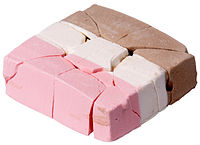
Photo from wikipedia
Abstract Vacuum freeze-drying (VFD) is a dehydration method based on the sublimation of the liquid phase contained in a certain product, previously frozen, at low pressure and temperature. Since it… Click to show full abstract
Abstract Vacuum freeze-drying (VFD) is a dehydration method based on the sublimation of the liquid phase contained in a certain product, previously frozen, at low pressure and temperature. Since it is a time and energy consuming process, it is crucial to select the best processing conditions to minimize drying duration, thus reducing the energy requirement. Additionally, product temperature must be monitored since it plays an important role in preserving product quality. The aim of this study was to develop a Diffuse Interface Model (DIM) for in-silico simulation of the freeze-drying process of individually frozen products. Due to the geometrical features of the samples, and to the role of radiation in the heat transfer to the product, the usual one-dimensional approach is inappropriate. Using a DIM, each cell of the computational domain can be described as a porous solid matrix filled by ice and vapor with a time-varying composition, thus allowing the use of a fixed computational grid and making the computation effort less demanding in comparison to moving interface-based models. Drying of eggplant cubic samples was considered as case study: model parameters were estimated by fitting the experimentally measured product temperature and drying time to the calculated ones. The model was proven to be reliable in providing an accurate estimate of both the drying time and the product temperature. Therefore, it can be used for off-line process design and optimization, minimizing the experimental effort required to design and optimize the process.
Journal Title: Drying Technology
Year Published: 2020
Link to full text (if available)
Share on Social Media: Sign Up to like & get
recommendations!